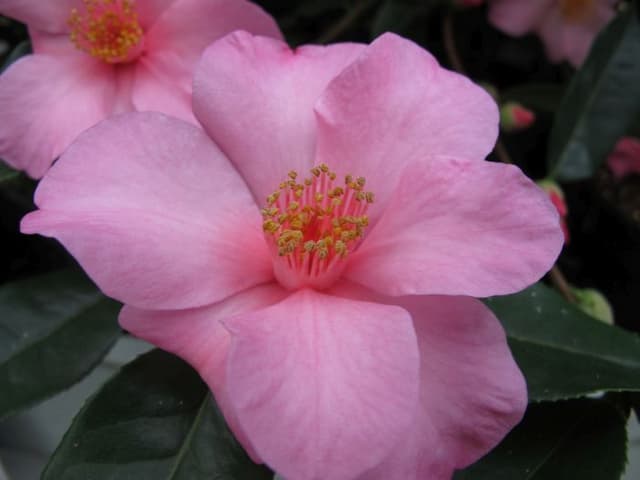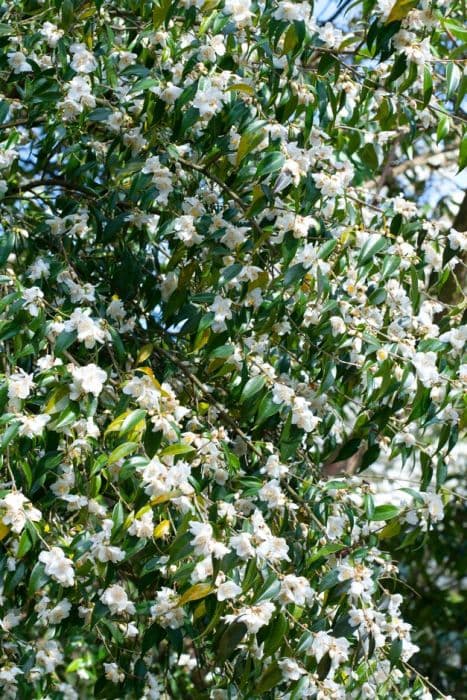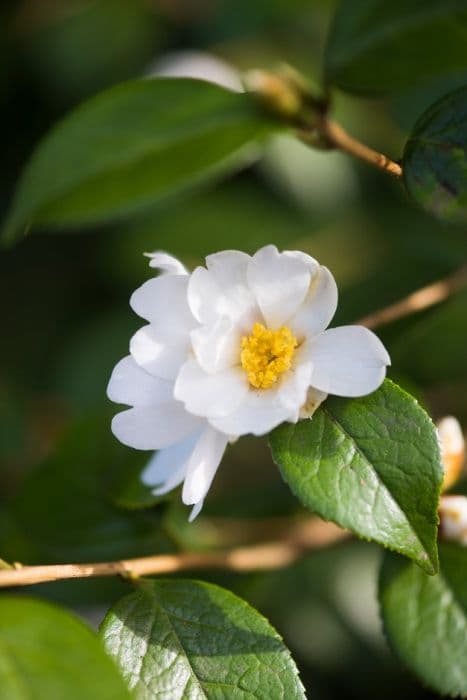Japanese Camellia Camellia japonica 'R.l. Wheeler'

ABOUT
The Camellia japonica 'R.L. Wheeler' is a flowering shrub known for its striking blossoms that can be a focal point in any garden. The flowers are large and peony-like, typically displaying a lush pink color with numerous petal layers creating a ruffled, voluminous effect. These blooms are further highlighted by a central mass of golden-yellow stamens that add a delightful contrast to the petals. The leaves of this plant are glossy, dark green in color, and oval-shaped with a leathery texture, which provides a perfect backdrop to the showy flowers. The foliage is evergreen, meaning that it provides a year-round visual interest even when the plant is not in bloom. The overall presentation of Camellia japonica 'R.L. Wheeler' is one of elegance and sophistication, making it a popular choice for gardens.
About this plant
 Names
NamesFamily
Theaceae
Synonyms
Japanese Camellia, Common Camellia, Rose of Winter
Common names
Camellia japonica 'R.l. Wheeler'.
 Toxicity
ToxicityTo humans
The Camellia japonica, commonly known as the Japanese camellia, is not considered toxic to humans. Therefore, ingesting parts of this plant typically does not result in poisoning or adverse health effects.
To pets
The Camellia japonica, or Japanese camellia, is also not considered toxic to pets. Ingesting parts of this plant should not cause poisoning or serious health issues for animals such as cats and dogs.
 Characteristics
CharacteristicsLife cycle
Perennials
Foliage type
Evergreen
Color of leaves
Dark green
Flower color
Pink
Height
6-10 feet (1.8-3 meters)
Spread
6-10 feet (1.8-3 meters)
Plant type
Shrub
Hardiness zones
7-9
Native area
Japan
Benefits
 General Benefits
General Benefits- Ornamental Beauty: Camellia japonica 'R.L. Wheeler' is cherished for its large, showy flowers that add striking visual appeal to gardens and landscapes.
- Year-Round Interest: This plant has glossy, evergreen leaves that provide a lush backdrop throughout the year, even when not in bloom.
- Shade Tolerance: It can thrive in partial shade, making it ideal for planting under taller trees or in areas with filtered sunlight.
- Drought Resistance: Once established, Camellia japonica is relatively drought-tolerant, requiring minimal watering in temperate climates.
- Versatile Landscaping: It can be used in various landscaping designs, including as hedges, specimen plants, or container plants.
- Minimal Pests and Diseases: This plant is resistant to many pests and diseases, reducing the need for chemical treatments.
- Seasonal Blooms: Blooming in the late winter to early spring, it provides color during times when few other plants flower.
- Attracts Pollinators: Flowers can attract bees and other pollinators, supporting local biodiversity and ecosystems.
- Long-Lived: Camellia japonica plants are known for their longevity, often living for 100 years or more, providing long-term landscaping stability.
 Medical Properties
Medical PropertiesThis plant is not used for medical purposes.
 Air-purifying Qualities
Air-purifying QualitiesThis plant is not specifically known for air purifying qualities.
 Other Uses
Other Uses- Artistic Inspiration: Camellia japonica 'R.L. Wheeler' flowers have been used as subjects in traditional Japanese paintings and modern photography due to their vibrant colors and symmetrical beauty.
- Natural Fabric Dyes: Petals of the Camellia japonica 'R.L. Wheeler' can be used to produce natural fabric dyes, resulting in unique shades of pink and red.
- Floral Arrangements: The plant's flowers are often used in floral arrangements and bridal bouquets because of their longevity and rich color.
- Culinary Garnish: Edible varieties of Camellia japonica 'R.L. Wheeler' can add an ornamental touch when used as a garnish for plates or cakes.
- Scented Oils: Although less known, the flowers can be infused into oils to create fragrant concoctions for use in aromatherapy and perfumery.
- Symbolic Gift: In certain cultures, Camellia japonica 'R.L. Wheeler' plants are given as gifts to symbolize love, admiration, and the coming of spring.
- Craft Material: Dried petals and leaves can be used in crafting, for example, in making homemade paper or potpourri.
- Educational Tool: Schools might use Camellia japonica 'R.L. Wheeler' in botanical studies due to its distinct flower anatomy and pollination mechanism.
- Photography Projects: The striking appearance of Camellia japonica 'R.L. Wheeler' makes it an excellent subject for macro and time-lapse photography experiments.
- Mood Enhancer: Simply having Camellia japonica 'R.L. Wheeler' in a room can boost moods with its bright colors and lush foliage, even though it’s not directly related to air purification.
Interesting Facts
 Feng Shui
Feng ShuiThe Camellia is not used in Feng Shui practice.
 Zodiac Sign Compitability
Zodiac Sign CompitabilityThe Camellia is not used in astrology practice.
 Plant Symbolism
Plant Symbolism- Admiration: The Camellia japonica is often associated with admiration due to its beauty and perfection in form.
- Perfection: Its perfectly arranged petals symbolize the ideal or a quest for perfection in many cultures.
- Love: The Camellia, being a flower that blooms in the colder season, represents a love that endures through challenges and time.
- Longevity: The plant's ability to live for many years and its evergreen leaves symbolize a wish for a long and prosperous life.
- Gratitude: In some contexts, giving a Camellia expresses gratitude or recognition of someone's excellence.
- Affection: With its lush, full blooms, the Camellia can also denote affection towards someone special.
- Deep Desire: The intense and vivid colors of some Camellia varieties can signify a deep longing or yearning.
 Water
WaterJapanese Camellia (Camellia japonica 'R.L. Wheeler') prefers consistently moist soil, so it's important to water it deeply whenever the top inch of soil feels dry to the touch. Typically, this equates to watering once a week, but this frequency may need to increase during periods of drought or extreme heat. Provide about one to one and a half gallons of water per plant for each watering session to ensure the moisture reaches the deep roots. During the winter, reduce the amount of water as the plant requires less moisture due to the dormant growing season.
 Light
LightJapanese Camellia thrives in partial shade, ideally benefiting from morning sunlight and afternoon shade, as direct sunlight can be too intense and cause the foliage to burn, especially in hotter climates. An eastern exposure or a spot under a canopy of tall trees that allows dappled light to filter through is ideal. It's important to protect the Camellia from the harsh afternoon sun to prevent stress and damage to the plant.
 Temperature
TemperatureJapanese Camellias are best suited to a temperate climate with temperatures ranging from 40°F to 85°F. They can survive minimum temperatures down to around 10°F but may experience cold damage below this threshold. Ideally, maintaining a temperature range within 60°F to 75°F is most conducive to the health and flowering of Camellias.
 Pruning
PruningJapanese Camellia should be pruned for shaping and to remove any dead or weak wood, which helps maintain the plant's health and vigor. It is best to prune the Camellia just after the blooming period in spring, as pruning too late can remove the developing buds for next season's flowers. Thinning out dense branches every few years encourages better air circulation and light penetration into the plant's canopy.
 Cleaning
CleaningAs needed
 Soil
SoilJapanese Camellia ('R.L. Wheeler') thrives in well-draining, acidic soil with a pH of 5.5 to 6.5. A mix consisting of 1/3 pine bark, 1/3 coarse sand or perlite, and 1/3 peat moss is ideal.
 Repotting
RepottingJapanese Camellias like 'R.L. Wheeler' should be repotted every 2 to 3 years to refresh the soil and allow root expansion; young plants might need annual repotting.
 Humidity & Misting
Humidity & MistingJapanese Camellia 'R.L. Wheeler' prefers high humidity levels, ideally between 50-60% for optimal growth.
 Suitable locations
Suitable locationsIndoor
Keep in bright indirect light, ensure high humidity.
Outdoor
Plant in partial shade, sheltered from strong winds.
Hardiness zone
7-9 USDA
 Life cycle
Life cycleCamellia japonica 'R.L. Wheeler', commonly known as the Japanese camellia, begins its life cycle when the seeds germinate in moist, well-drained soil, usually in spring. After germination, seedlings emerge and develop into young plants with characteristic glossy green leaves. As the plants mature, they undergo a vegetative growth phase, producing more leaves and stems, and eventually forming a shrub-like structure. The Japanese camellia enters a reproductive phase in late winter to spring, producing large, showy flowers ranging from pink to red. Following pollination, the flowers develop into seed capsules which, once mature, open to release seeds, completing the life cycle. Pruning after flowering helps maintain shape and encourages new growth for the following season's blooms.
 Propogation
PropogationPropogation time
Spring to early summer
The most popular method of propagation for the Camellia japonica 'R.L. Wheeler', commonly known as the camellia, is through semi-hardwood cuttings. This technique is typically carried out in late summer, after the plant’s growth has begun to slow and the stems are maturing. Cuttings should be 4 to 6 inches long with several leaves left on the upper end. The lower cut should be made just below a leaf node where rooting hormones can be applied to enhance root development. The cuttings are then inserted into a soil mix that provides good drainage, such as a combination of peat, perlite, and sand. The potted cuttings should be kept moist and in a well-lit area without direct sunlight until roots have developed, which usually takes several weeks to a few months. The new plants can be transplanted outdoors after they have established a strong root system and when the risk of frost has passed.









